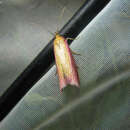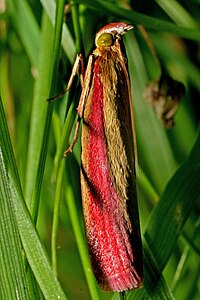en
names in breadcrumbs


Oncocera semirubella is a small moth of the family Pyralidae. It is found in European regions, including the British Isles,[2] and East Asia (e.g. China,[3] Japan,[4] South Korea[5] and Taiwan[6]).
The wingspan is 26–30 mm. The adult moth flies in one generation from the end of June to August.[1] It is easily disturbed from short grassland, flies from dusk onwards, and is attracted to light and sugar.[2]
The larvae feed on bird's-foot trefoil (Lotus corniculatus), white clover, Ononis species, horseshoe vetch and Medicago species.
Oncocera semirubella is a small moth of the family Pyralidae. It is found in European regions, including the British Isles, and East Asia (e.g. China, Japan, South Korea and Taiwan).

 Figs.1, 1a, 1b, 1 c larvae in various stages 1d pupa
Figs.1, 1a, 1b, 1 c larvae in various stages 1d pupa The wingspan is 26–30 mm. The adult moth flies in one generation from the end of June to August.[1] It is easily disturbed from short grassland, flies from dusk onwards, and is attracted to light and sugar.
The larvae feed on bird's-foot trefoil (Lotus corniculatus), white clover, Ononis species, horseshoe vetch and Medicago species.